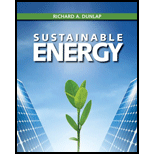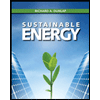
Sustainable Energy
1st Edition
ISBN: 9781133108689
Author: Richard A. Dunlap
Publisher: Cengage Learning
expand_more
expand_more
format_list_bulleted
Concept explainers
Question
Chapter 3, Problem 5P
To determine
Find the equivalent power of coal in watts.
Expert Solution & Answer
Want to see the full answer?
Check out a sample textbook solution
Students have asked these similar questions
2. A series of gears are mounted on a 40mm diameter steel shaft. Take G = 75 GPa.
(i) Draw the torque load diagram.
(ii) Determine the angle of twist of gear B relative to gear A.
(iii) Determine the maximum shear stress and it's location along the shaft.
600 N-m
900 N-m
200 mm
200 mm
200 mm
500 Nm
300 N·m
200 mm
500 N-m
1. The figure below shows a circular shaft with three sections. The length of each section is
50mm. (E 500 MPa).
=
(i) Draw the axial load diagram of the circular shaft.
(ii) Determine the average normal stress at points A, B and C.
(iii) Determine the maximum deformation and it's location along the shaft.
10 mm
5 mm
5 mm
B
300 N A 900 N
800 N C 200 N
02: For the gravity concrete dam shown in the figure, (the vertical stresses at toe and heel ((Pmax & Pmin) are
199 and 52 ton/m respectively.
following data are available:-
-Unit weight of concrete (ycone)-24 ton/m³
-Neglect Wave pressure, silt pressure, ice force and earth quake force.
#-0.65
Find factor of safety against sliding and overturning (F.Sslid & F.Sover)
AS
115 m
8 m
120 m
Solve with sketch on paper
Knowledge Booster
Learn more about
Need a deep-dive on the concept behind this application? Look no further. Learn more about this topic, civil-engineering and related others by exploring similar questions and additional content below.Similar questions
- please solve and neglect the distance between the two angles for simplecalculationsarrow_forwardDetermine the required solids retention time (SRT) of a completely mixed activated sludge aeration tank for a conventional activated sludge system treating a design flow rate of 34,560 m³/d, where the effluent standards are 30.0 mg/L for BODs and 30.0 mg/L for total suspended solids (TSS). Assume that the BOD5 of the effluent TSS is 70% of the TSS concentration. Assume the BODs concentration leaving the primary clarifier is 128 mg/L that the MLVSS concentration (X₂) is 2,500 mg/L. Assume the following values for the growth constants: Ks 100 mg/L BODS ⚫ Hm - 2.5 d 1 kd = 0.050 d 1 Y = 0.50 mg VSS/mg BODs removed Express your answer in days and round to the nearest 0.1.arrow_forwardFor the gravity concrete dam shown in the figure, the following data are available: Unit weight of concrete (7)-2.4 ton/m Neglect Wave pressure, silt pressure, ice force and earth quake force) -0.65, (7)-1 ton/m' Solve on paper and sketch Find factor of safety against sliding and overturning (F.Sa & F.S), If heel and toe stresses (Pain & P) are 57.17ton/m2 and 84.53 ton/m² respectively. Solve in table on paper w.s.l 83m 10m 8m 80marrow_forward
- 1. Find moments of inertia around horizontal and vertical centroid axes for given 6 cross sections. 30cm 4) "T 0cm 1116 5) 20cm 5cm 6)arrow_forward1. Find moments of inertia around horizontal and vertical centroid axes for given 6 cross sections. 1) 30cm 5cm 10cm 20cm 2) 3)arrow_forwardAn anchored sheet-pile bulkhead is shown in the figure below. Let L₁ = 2 m. L₂ =6 m. l₁ = 1 m = 17 kN/m². sat -18.86 kN/m², '=32°, and c=27 kN/m². Use the free earth support method. Anchor Sand = 0 Water table L Sand Ysat c' = 0 Clay = 0 1. Determine the theoretical depth of embedment, D. (Enter your answer to three significant figures.) D= m 2. Calculate the anchor force per unit length of the sheet-pile wall. (Enter your answer to three significant figures.) F= kN/marrow_forward
- Calculate the dry mass of activated sludge (✗a) produced in wastewater treatment system where the flow rate is 7,500 m³/day, the BOD concentration in the primary effluent (i.e., the BOD concentration in the wastewater going to the aeration basin) is 75 mg/L, the soluble BOD concentration in the liquid effluent of the secondary clarifier is 10 mg/L, and the system is operating with an SRT of 3 days. Assume true yield is 0.5 g VSS per g BOD and the decay rate (i.e., bч or kd) is equal to 0.1 days 1. Assume the system does not achieve nitrification and that the mass of cell debris, nonbiodegradable VSS, and influent inert TSS is negigible. Express your answer in kg/day and round to the nearest 0.1.arrow_forwardIn a school, there are three clubs: Drama Club, Music Club, and debating Club. Some students are members of multiple clubs, while others are only members of one club. a. How would you represent this scenario using set notation and Venn Diagram?arrow_forwardDetermine the required volume of a completely mixed activated sludge aeration tank for a conventional activated sludge system treating a design flow rate of 34,560 m³/d, where the effluent standards are 30.0 mg/L for BOD5 and 30.0 mg/L for total suspended solids (TSS). Assume that the BOD5 of the effluent TSS is 70% of the TSS concentration. Assume the BOD5 concentration leaving the primary clarifier is 128 mg/L that the MLVSS concentration (Xa) is 2,500 mg/L. Assume the following values for the growth constants: • K = 100 mg/L BOD5 • μm = 2.5 d−1 • kd = 0.050 d 1 Y = 0.50 mg VSS/mg BOD5 removed Express your answer in m³ and round to the nearest integer.arrow_forward
- Determine the daily volume of methane and total gas produced in an anaerobic digester if the biosolids flow rate is 200 m³/d and the COD concentration going into the reactor is 5,000 g/m³. Assume yield is 0.05 g VSS/g COD, that there is 90% COD removal, and that methane is 50% of the total gas volume. Assume that actual gas production at the operating temperature is 0.4 L of CH4 per g of COD. Express your answer in m³/d and round to the nearest integer.arrow_forwardConsidering the following stoichiometry shown below, calculate the theoretical true yield of bacteria that use the organic molecule butyrate (C4 H7O2¯) as their source of energy. Express your answer with the units of grams of C5 H7O2 N per gram of O2 and round to the nearest 0.01. Stoichiometric relationship for the microbial oxidation of butyrate with O₂ as terminal electron acceptor 2C4H;O, +502+NHẠ* → C5 H7O2 N + 5H2O+ HCO3 + CO2 Stoichiometric relationship for the complete oxidation of butyrate C4H7O2 +502 + H+ →4CO2+4H₂Oarrow_forwardRefer to the figure below. Given: L₁ = 4m, L2 = 8 m, l₁ = l2 = 2 m, y = 16 kN/m³, Ysat = 18.5 kN/m³, and ' = 26°. Use the charts presented below the answer fields. Sand c' = 0 Anchor L₁ Water table Sand Ysat c' 0 $' Sand c' = 0 1. Determine the theoretical depth of penetration. (Enter your answer to two significant figures.) D= m 2. Determine the anchor force per unit length. (Enter your answer to two significant figures.) F= kN/m 3. Determine the maximum moment in the sheet pile. (Enter your answer to two significant figures.) CDL₁ Mmax = 0.5 kN-m/m 0.4- -24= &' 26° 0.3 -28° 30° 32° 0.2 34° 36° 38° 0.1 0.0 0.1 0.2 0.3 0.4 0.5 1.18 1.16 1.14 1.12 1.10 1.08 1.06 1.04 4₁/(L₁+ L₂2) L₁ 4₁+12 0.3 0.2 = 0.4arrow_forward
arrow_back_ios
SEE MORE QUESTIONS
arrow_forward_ios
Recommended textbooks for you

 Engineering Fundamentals: An Introduction to Engi...Civil EngineeringISBN:9781305084766Author:Saeed MoaveniPublisher:Cengage Learning
Engineering Fundamentals: An Introduction to Engi...Civil EngineeringISBN:9781305084766Author:Saeed MoaveniPublisher:Cengage Learning Solid Waste EngineeringCivil EngineeringISBN:9781305635203Author:Worrell, William A.Publisher:Cengage Learning,
Solid Waste EngineeringCivil EngineeringISBN:9781305635203Author:Worrell, William A.Publisher:Cengage Learning, Sustainable EnergyCivil EngineeringISBN:9781133108689Author:Richard A. DunlapPublisher:Cengage Learning
Sustainable EnergyCivil EngineeringISBN:9781133108689Author:Richard A. DunlapPublisher:Cengage Learning


Engineering Fundamentals: An Introduction to Engi...
Civil Engineering
ISBN:9781305084766
Author:Saeed Moaveni
Publisher:Cengage Learning

Solid Waste Engineering
Civil Engineering
ISBN:9781305635203
Author:Worrell, William A.
Publisher:Cengage Learning,

Sustainable Energy
Civil Engineering
ISBN:9781133108689
Author:Richard A. Dunlap
Publisher:Cengage Learning